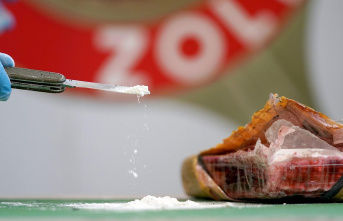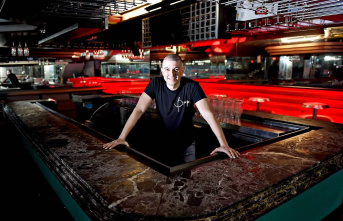OTTAWA | A lighting designer died in excruciating pain because he was exposed to asbestos in the old Radio-Canada tower, but the public channel refuses to compensate his widow.
• Read also: Montreal: at least $28 million more to restore city hall
• Read also: Asbestos causes temporary school closure in Saguenay
“In the family, we were proud to say that Réal worked at Radio-Canada. Now we are not. He would still be there if he had worked elsewhere,” breathes Linda Grandmont, widow of Réal Truchon.
Mr. Truchon was a lighting technician, lighting designer and technical instructor at Maison de Radio-Canada in Montreal.
La Fureur, Bye Bye, L'heure de Glory, the RDI information center... he made all the sets and won several prizes, including a Gémeau.
"The dance of lights of variety shows, that was him," says Ms. Grandmont.
Entered the great tower on René-Lévesque Boulevard at the age of 18, this enthusiast spent his entire life in the service of the public channel until his retirement. He died in October 2020.
He died of peritoneal mesothelioma, a rare and extremely destructive cancer most often caused by the ingestion of asbestos fibers. He was 64 years old.
Ten months of suffering
Less than ten months passed between the appearance of the first symptoms, in January 2020, and his last breath.
In the meantime, he lived on morphine, the pain was so unbearable.
“It was scary,” says Ms. Grandmont, a sob in her voice. The morphine, the hospital bed in the living room, the showers twice a week with the help of the CLSC... I don't want anyone to go through that. »
Shortly after Mr. Truchon's death, the Commission for Standards, Equity, Health and Safety at Work (CNESST) ruled in two decisions that he had been contaminated at work.
"He was exposed directly and indirectly to asbestos for about 25 years as part of his work as a lighting technician," says the CNESST in the file obtained by Le Journal.
Mr. Truchon set up and dismantled television studios and designed the lighting there. For this, he spent his time with his nose in the false ceilings and the walls, with both hands in the electric cables.
Contestation
Although the decisions of the CNESST are based on the expertise of doctors who treated Mr. Truchon, Radio-Canada disputes them, because it considers them “ill-founded in law and in fact”.
The state-owned company thus prevents the widow from receiving the death benefit to which the decisions of the CNESST entitle her.
The retiree therefore had to hire a lawyer to defend herself in court.
"I'm not able to grieve because of the endless paperwork," she says. I myself ended up in the hospital two months ago because of depression. »
Ms. Grandmont is nevertheless determined to go all the way.
"I won't let go. My spouse wanted his file to go further to help his colleagues who might be in the same situation,” she said.
The Radio-Canada communications union denounces the employer's relentlessness against the widow of a deceased worker and is worried about the health of other employees who may also have been in contact with asbestos.
"We consider this challenge to be particularly shocking and we ask Radio-Canada not to add additional stress to Mr. Truchon's widow," union president Pierre Tousignant told the Journal.
“We have already asked the management of Radio-Canada on several occasions not to persist in this file,” he insists.
“We challenged the file since it is an occupational disease file and unfortunately, we have a very short deadline provided for in the law to analyze the file and protect our rights”, justifies the spokesperson for the broadcaster, Marc Pichette.
Other potential victims
The case is all the more sensitive since Mr. Truchon may not be the only victim of asbestos at Radio-Canada.
Thousands of people have worked in the building on René-Lévesque Boulevard in Montreal since its construction in 1973. Some 3,000 people worked there when the public channel moved to its new premises between 2020 and 2021.
"We have also asked them to take serious steps to ensure that there are no other similar cases," said Tousignant, who regrets that the union's requests in this case remain unanswered.
Mr. Pichette ensures that the public channel respects “all the regulations in force to protect employees and contractors”.
Well-known contamination
The Société Radio-Canada is well aware of the presence of asbestos in its former building.
"Because of the presence of asbestos and outdated technologies in many studios, it would have cost us 170 million [de dollars] to bring the tower up to date," said SRC vice-president Michel Bissonnette. , to justify the sale of the building in 2017.
The Mach group, which acquired the tower for $42 million, intends to build offices and housing there.
Symptoms
Sources: Cancer Care Ontario, National Reference Center for Rare Peritoneal Tumors
1












